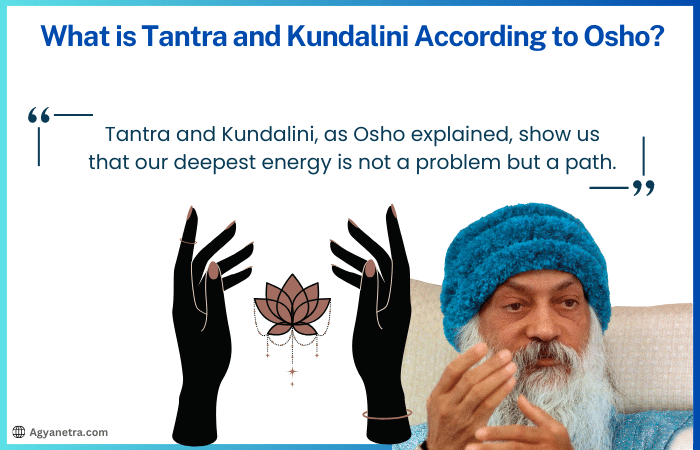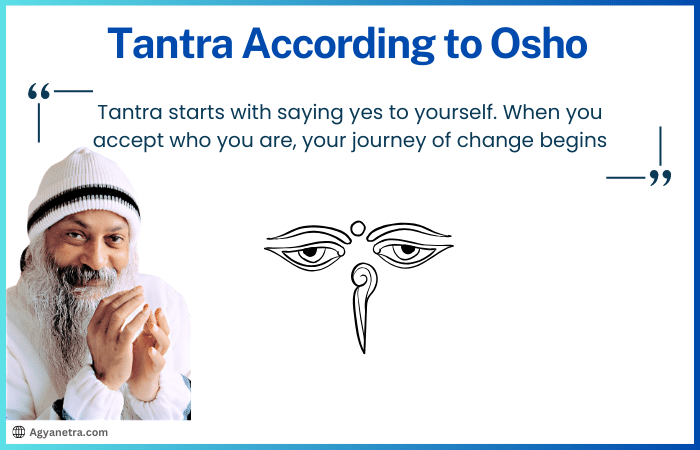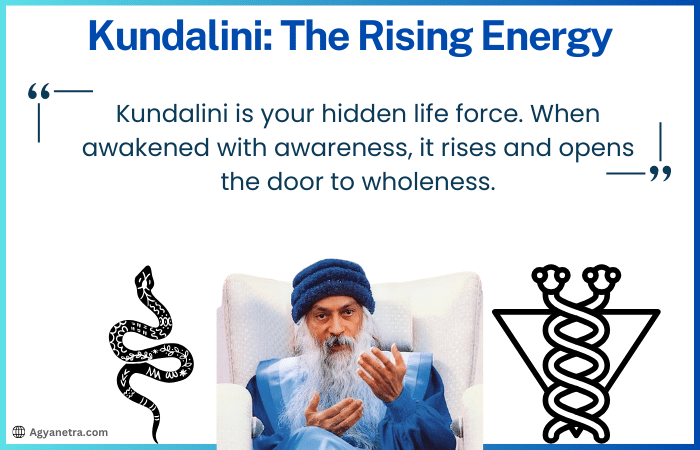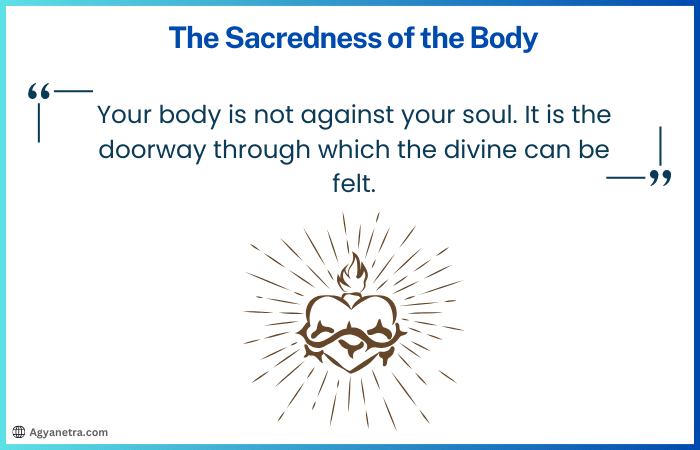What is Tantra and Kundalini According to Osho? Osho did not see Tantra as a taboo subject or Kundalini as a mystical secret. Instead, he explained them in simple ways that anyone can understand and practice in daily life.
If you have ever wondered whether Tantra is only about sexuality or how Kundalini can actually awaken, this article will give you clear answers.
As you read further, you will discover how Osho turned desire into a doorway, sexuality into sacred energy, and Kundalini into a real path toward spiritual awakening.
What is Tantra and Kundalini According to Osho?
Sexuality is often treated as something to be suppressed with shame or sold like a commodity, but rarely is it understood in its true essence.

Osho’s interpretation of Tantra brings a refreshing shift in perspective. He described it as bold, spiritually rooted, and liberating both psychologically and emotionally.
Instead of choosing between indulgence or renunciation, Osho explained Tantra as a path of transformation where sexuality becomes a doorway to higher consciousness.
According to Osho, when sexuality is lived with awareness instead of suppression or blind indulgence, it awakens deeper energy within us.
This awakening is what leads to Kundalini, the coiled spiritual force at the base of the spine, rising upward toward complete consciousness.
Through this lens, Tantra is not just about sacred sexuality but about integration, where desire evolves into devotion and ultimately into meditation.
Tantra According to Osho
To understand Osho’s view of Tantra, it is important to first see how it contrasts with mainstream teachings.

Many spiritual traditions have regarded desire as something to fight against or eliminate. Osho challenged this view.
He saw desire, especially sexual desire, as holding immense potential. Instead of suppression, he encouraged seekers to accept themselves fully.
Osho explained that Tantra begins with radical acceptance.
Rather than labeling sexuality as sinful, Tantra invites us to see ourselves as living mysteries filled with multidimensional energies.
He criticized religions that called for repression, saying such denial only forces desires into the unconscious, where they resurface in distorted ways.
In this sense, Osho’s Tantra asks us to embrace life in its totality. It is not about escape but about presence. Desire, when observed consciously, transforms itself into love and meditation.
More posts like this:
- Kundalini Yoga for Beginners
- Raj Yoga in Kundalini
- Awakening the Divine Masculine
- Spiritual Downloads Connecting to Divine Portal
- Buddha Aditya Yoga
Sexuality as Sacred Energy
For Osho, sexuality was not to be condemned or worshipped as an ultimate end. He called it the raw material for spiritual growth. He compared it to the lowest rung on a ladder.
While one starts at the bottom, the purpose is to climb higher toward union with the universe.
In modern times, sexuality is often reduced to physical pleasure and instant gratification.
Osho invited seekers to treat sexuality as sacred energy. By bringing awareness into sexual acts, people can transform them into meditative experiences.
For example, two partners may engage in lovemaking unconsciously, chasing physical pleasure. But if they approach it with mindfulness, observing each movement, each breath, and each emotion, it becomes a ritual of awareness. In such a state, physical intimacy goes beyond the body, evolving into spiritual connection.
This teaching redefines relationships. It shifts the focus from chasing gratification to cultivating deeper union, not only with another person but with existence itself.
From Orgasm to Samadhi
One of Osho’s boldest insights was the link between orgasm and meditation.
He explained that during orgasm, time disappears, ego dissolves, and duality vanishes. For a brief moment, a person experiences unity.
This moment, though often unnoticed, is a glimpse of Samadhi, the highest state of consciousness.
Most people, unaware of this potential, repeat the act of orgasm for its physical sensation.
They miss the chance to experience its deeper meaning. Osho taught that if orgasm is lived with awareness, it becomes a doorway to transcendence.
In sacred lovemaking, partners let go of their egos and merge into a higher state of being.
Tantra symbolizes this as the union of Shiva and Shakti, representing consciousness and energy.
Osho emphasized not to escape sex but to enter it with awareness so that sex transforms into love, and love into meditation.
Imagine two scenarios. In one, a couple chases repeated orgasms without reflection, creating a cycle of desire.
In the other, they approach the same act consciously, with meditation and presence.
The first keeps them bound, the second opens a path to awakening. This is the difference awareness makes.
Desire and Transformation
Osho often expressed this teaching in simple words: lust is unconsciousness, love is awareness, and meditation is transcendence.
Desire, when unconscious, traps us in repetition. We keep looking outward for fulfillment, forgetting the power within.
From Osho’s perspective, Tantra is not about denying desire but about what we do with it.
Desire can remain a restless force, or it can become a tool for awakening. Awareness is what transforms it.
For example, when a person feels sexual desire, they may either suppress it out of shame or indulge in it blindly.
Both keep them unconscious. Osho suggested a third way — to observe the desire without judgment, to feel it fully, and allow awareness to change its quality. With time, such observation transforms lust into love and love into meditation.
Kundalini: The Rising Energy
Kundalini plays a central role in Osho’s teaching of Tantra. He explained that Kundalini is not a mystical story but the very life force within us.

It rests coiled at the base of the spine, waiting to be awakened.
When awakened, Kundalini energy begins to rise upward through different centers of the body and consciousness.
It passes through layers of fear, shame, ego, creativity, and love, gradually leading to a state of wholeness.
Osho saw Kundalini awakening not as chasing visions or powers but as a natural flowering of awareness.
This energy, when redirected inward, turns ordinary life into extraordinary presence.
It reshapes not only the body but also the mind and soul, leading to spiritual awakening.
The Role of Awareness
Awareness is the foundation of Osho’s Tantra. He often said that awareness does not glorify desire, it transforms it.
Without awareness, people either repress desires or indulge in them unconsciously. Both approaches keep them trapped. With awareness, energy becomes devotion and love.
Take the example of someone struggling with shame around their desires.
Repressing them only creates conflict, while indulging creates dissatisfaction. Awareness, however, changes the dynamic.
Observing the desire with clarity removes its unconscious grip, allowing it to transform into higher energy.
Through awareness, sexuality becomes sacred, love becomes meditative, and even ordinary experiences like eating, breathing, or walking become moments of spiritual practice.
The Sacredness of the Body
Another key element in Osho’s view of Tantra is the body. He rejected the idea that the body is an obstacle to spirituality.

Instead, he called it a sacred portal. The body and the soul are not separate but connected. By entering the body with awareness, we can use it as a pathway to transcendence.
For example, meditation does not mean denying physical existence. It means being so present within the body that it leads to stillness and awakening.
Lovemaking, breathing exercises, or even simple body awareness can become forms of meditation when approached consciously.
By honoring the body, Tantra integrates physical and spiritual dimensions, showing that the divine can be found in every aspect of human life.
Integration, Not Rejection
Perhaps the most valuable aspect of Osho’s teaching is his call for integration. He did not ask people to escape from humanity but to embrace it fully.
Desire, emotions, and even struggles are not obstacles but opportunities for awareness.
Stillness, according to Osho, comes not from extremes of indulgence or repression but from balance and integration.
Desire becomes devotion, sexuality transforms into spirituality, and life itself becomes meditation.
For seekers today, this message is especially important. In a world filled with distractions and pressures, Osho’s Tantra reminds us to slow down, become aware, and direct our energy consciously.
Conclusion
What is Tantra and Kundalini according to Osho? It is a vision where sexuality is not rejected or worshipped but understood as sacred energy. Tantra, in his words, is not indulgence or denial but transformation.
When lived with awareness, sexuality becomes love, love becomes meditation, and meditation leads to transcendence.
Kundalini, the life force at the base of the spine, is awakened not by force but through presence and conscious living.
As it rises, it carries us beyond fear, shame, and ego into wholeness and spiritual awakening.
Osho’s teaching shows that lust without awareness keeps us asleep, love with awareness awakens us, and meditation brings us to the divine.
Tantra, as he explained, is not only about sex but also about love, prayer, and the journey of integration. It is an invitation to be fully human while moving toward the sacred.
FAQs
What is Tantra and Kundalini according to Osho?
Osho explained Tantra as a path of acceptance and transformation, not indulgence or denial. Kundalini, he said, is the hidden spiritual energy at the base of the spine. When awakened with awareness, it rises upward, turning desire into love, meditation, and ultimately spiritual awakening.
Did Osho see Tantra only about sexuality?
No, Osho clarified that Tantra is not limited to sexuality. He saw sexuality as the starting point, the raw energy that can be transformed. With awareness, this energy grows into love, meditation, and union with the divine. For him, Tantra was about integration, not indulgence.
How did Osho explain Kundalini awakening?
According to Osho, Kundalini awakening happens through awareness, meditation, and presence. The energy at the spine rises step by step, passing through fear, ego, and love, until it reaches wholeness. He emphasized that Kundalini is real life force energy, not a mystical fiction.
What is the role of awareness in Osho’s Tantra?
Awareness is central in Osho’s Tantra. Without awareness, desire becomes unconscious repetition. With awareness, the same desire transforms into love and meditation. Osho taught that awareness is the key that changes sexuality into sacred energy and leads to conscious awakening.
Why did Osho connect orgasm and meditation?
Osho said orgasm gives a brief glimpse of meditation because in that moment, time stops and the ego dissolves. However, people usually chase the sensation instead of realizing its deeper meaning. For Osho, conscious lovemaking could become a step toward Samadhi, the state of spiritual union.
How is the body viewed in Tantra according to Osho?
Osho believed the body is not an obstacle but a portal to the divine. In Tantra, the body and soul are not separate. By entering the body with awareness—through breath, love, or meditation—ordinary experiences can become sacred and lead to transcendence.
What makes Osho’s view of Tantra different from traditional teachings?
Traditional teachings often treat desire as something to suppress. Osho’s Tantra welcomed desire as energy to be transformed. He criticized repression and instead encouraged acceptance, awareness, and integration. His approach made Tantra practical and human-centered, not limited to rituals or taboos.
Can Tantra and Kundalini help in daily life?
Yes, Osho taught that Tantra and Kundalini are not just mystical concepts but tools for daily living. By practicing awareness, even simple acts like eating, breathing, or loving can become meditations. Kundalini awakening brings balance, peace, and a deeper connection to oneself.

Vidushi Gupta is an accomplished writer and digital marketing expert with contributions to organizations like Miles Educomp and ICAI. She has authored nearly ten novels and worked as a Senior Content Writer and Digital Marketing Specialist at ESS Global and Shabd. Her Quora posts have amassed almost 20 million views, reflecting her belief in the transformative power of the written word.
